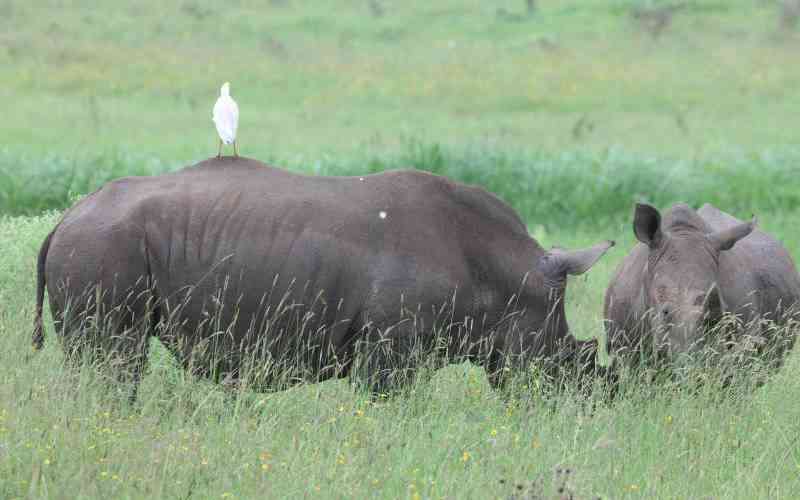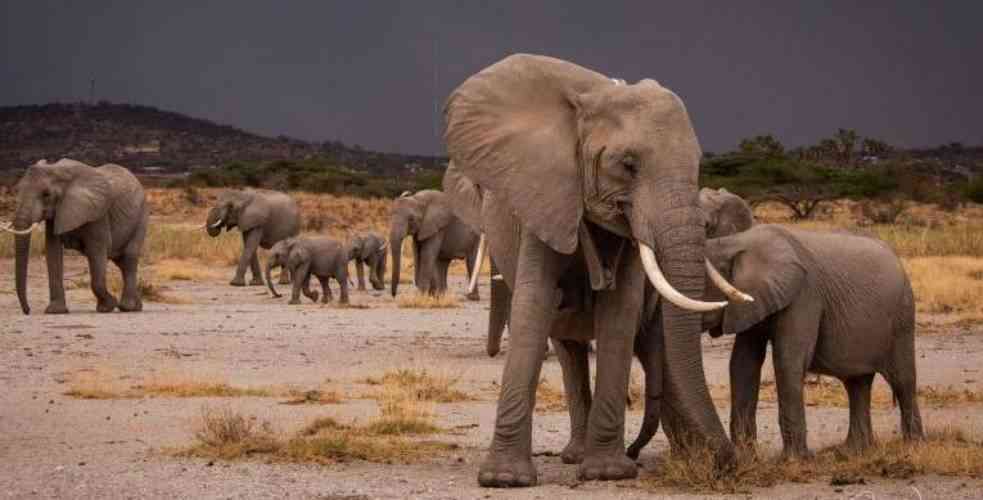 |
|
Government acknowledges there is unprecedented killing of rhinos and elephants. [Photo: File/Standard]
|
By Peter Orengo
VOI, KENYA: Kenya is on the spot for lax control of poaching following global increase in illegal ivory and rhino trade.
The latest incident saw an entire family of 12 elephants butchered by poachers at Bisadi area of Tsavo East National Park.
By January 7, Kenya Wildlife Service (KWS), a body mandated to conserve and manage the country’s wildlife resources said they were yet to make any arrest. At 22,000sqkm, Tsavo is the country’s largest single ecosystem and home to about 13,000 elephants, according to 2011 census.
35,000 elephants
The most recent report by Convention on International Trade in Endangered Species of Wild Fauna and Flora (Cites), shows a close match between trends in elephant poaching and large-scale ivory seizures, detecting the same patterns at different points in the illegal ivory trade chain.
According to Cites data, the greatest volumes of ivory was seized globally between 2009 and 2011.
In 2011, there were 14 large-scale ivory seizures – a double-digit figure for the first time in 23 years, when records were first compiled. They totalled an estimated 24.3 tonnes, more than in any previous year.
The large-scale seizures indicated participation of organised crime involving poachers, middlemen and buyers.
In Kenya, the first four months of 2012 witnessed alarming increase in elephant poaching, especially in Mount Kenya region, where it is believed there are a number of notorious elephant poachers. Recent estimates suggest 35,000 elephants are now being illegally killed in Africa every year.
The Government noticed the scale of the challenge last March and set aside significant resources to combat the poaching chain, from killing of elephants to marketing of ivory.
Ivory seized
Last year, a global conservation body, International Fund for Animal Welfare, warned Kenya is a leading transit route for illegal ivory. It further said the country is the source of several ivory seized in the Far East.
Recently, poachers killed seven rhinos and three elephants in the Northern Tourism Circuit that consists of Aberdares and Northern rangeland area. No arrests were made.
Stay informed. Subscribe to our newsletter
Latest statistics show that the number of elephants has dropped from 7,415 in 2008 to 6,361, while that of rare and endangered Grevy Zebra dropped to 1,870 from 2,400 over the same period.
This alarming trend points at the sophisticated nature of poaching and trade in wildlife products. Going with the recent incidents of elephant poaching, especially in the Northern rangelands of Laikipia to Marsabit, it reflects a new trend across many range states of Africa.
KWS blames the sophisticated nature of poaching on cartels run by large criminal syndicates.
“There is no doubt that Kenyan elephants are declining, with figures indicating that at least six elephants are killed monthly in national parks for their tusks,” said Ian Craig, a KWS board member and manager of the Northern Rangelands Trust.
Market demand
He says in March, KWS recognised the scale of the challenge and placed new resources to combat whole chain of poaching, from killing of elephants to marketing of ivory.
“New sniffer dogs were put in all the ports of entry, rangers were deployed into the most vulnerable areas, and many dealers were arrested.
The Government also mobilised communities to expose members of their own society that are involved in the illicit trade,” said Craig.
KWS director William Kiprono attributes the sharp reduction in numbers of elephants and rhinos to increased poaching occasioned by high market demand for ivory, especially in South East Asia and China.
“We will come up with a strategic plan to acquire advanced radio equipment, step up operations and work closely with wananchi to counter poachers,” he said. This year, poachers have killed six KWS rangers.
While unveiling their names on the Conservation Heroes Monument in Nairobi, Wildlife minister Noah Wekesa agreed that there was an unprecedented killing of rhinos and elephants and announced that he had formed an inter-agency committee to address the root problems of escalating poaching.
“This problem is not restricted to Kenya. It’s global. The scope and brutality of the illegal trade in ivory has been discussed in the US and UK,”?he said.
The minister noted that illegal ivory trade had been linked to bigger global issues of terrorism, illegal firearm, drug peddling and human trafficking.
Rangers we talked to said it might take more than sniffer dogs and radios to fight poachers.
“They are well-armed with sophisticated weapons capable of decimating any population of elephants. Some are connected to high places so they are untouchable,” said a game ranger, who requested not to be named.
“The African rhino is under serious threat from poachers who have intensified their search for rhino horns since 2007, driven by growing market demands in Asia,” said Joseph Okori, head of WWF African Rhino Programme.
Although there is no scientific proof of its medical value, rhino horn is highly prized in traditional Asian medicine, where it is grounded into powder or manufactured into tablets as treatment for a variety of illnesses such as nosebleeds, strokes, convulsions, and fevers.
African countries
This demand has created highly profitable and organised international poaching criminal syndicates which deploy advanced technologies ranging from night vision scopes, silenced weapons, darting equipment and helicopters to carry out their mission.
According to data from Lusaka Agreement Task Force, between 2000 and 2011 at least 77 incidents of wildlife specimen seizures at various entry and exit points in the far East have been reported.
These seizures, which originated from African countries include 78,328kg of ivory, 42 rhino horns and over 630 assorted live animals as well as more than 300 African grey parrots.
 The Standard Group Plc is a
multi-media organization with investments in media platforms spanning newspaper
print operations, television, radio broadcasting, digital and online services. The
Standard Group is recognized as a leading multi-media house in Kenya with a key
influence in matters of national and international interest.
The Standard Group Plc is a
multi-media organization with investments in media platforms spanning newspaper
print operations, television, radio broadcasting, digital and online services. The
Standard Group is recognized as a leading multi-media house in Kenya with a key
influence in matters of national and international interest.
 The Standard Group Plc is a
multi-media organization with investments in media platforms spanning newspaper
print operations, television, radio broadcasting, digital and online services. The
Standard Group is recognized as a leading multi-media house in Kenya with a key
influence in matters of national and international interest.
The Standard Group Plc is a
multi-media organization with investments in media platforms spanning newspaper
print operations, television, radio broadcasting, digital and online services. The
Standard Group is recognized as a leading multi-media house in Kenya with a key
influence in matters of national and international interest.










